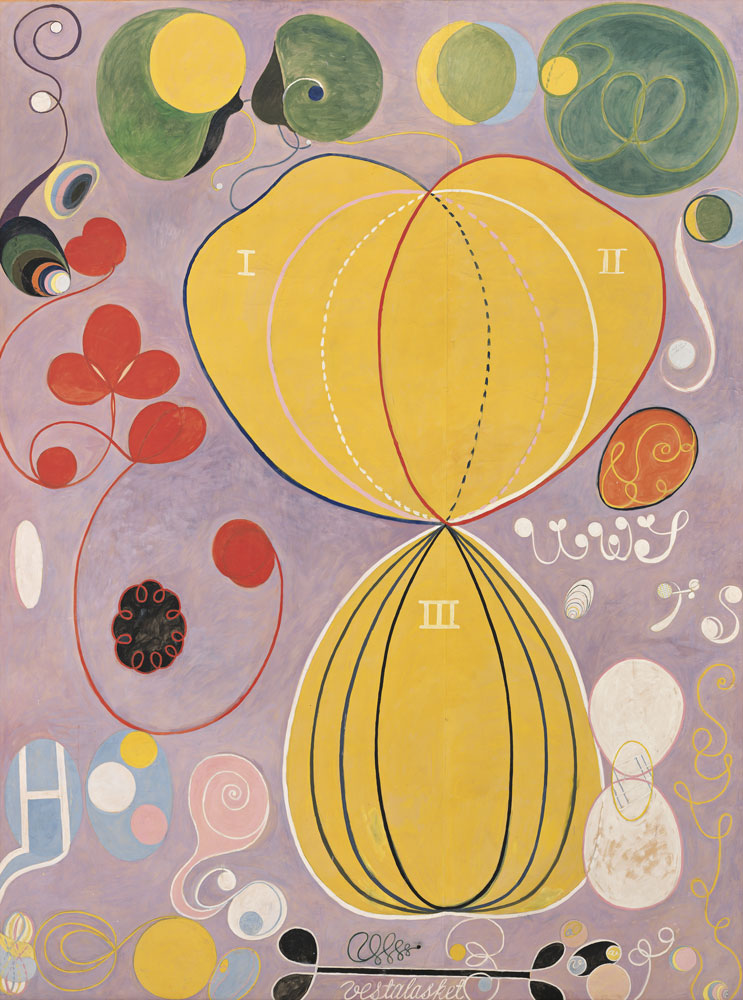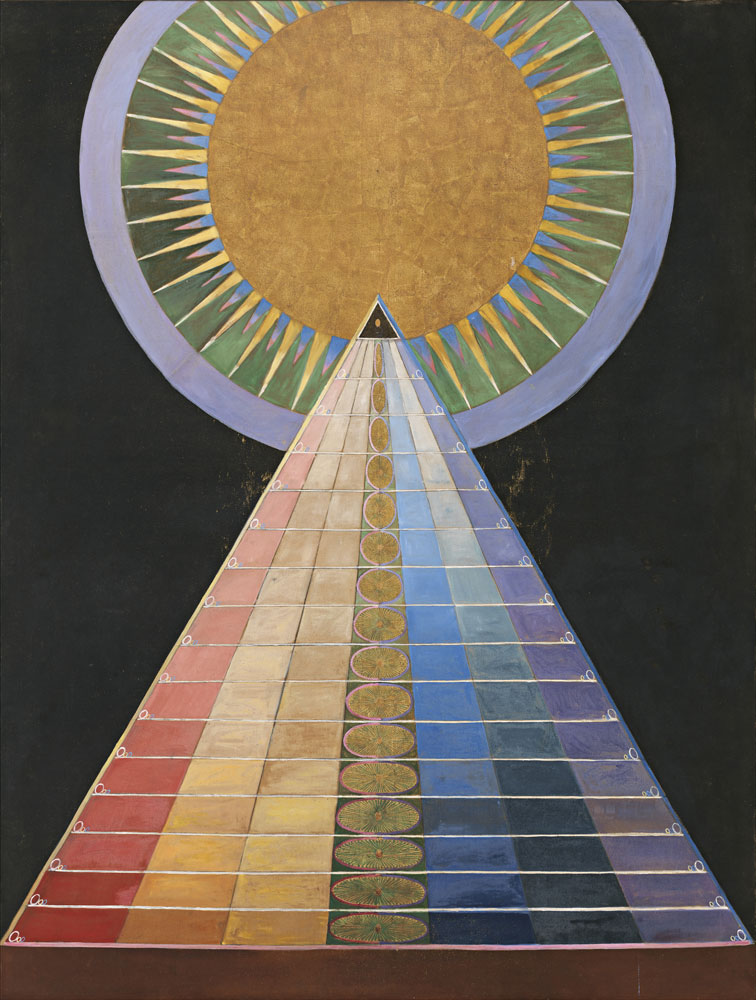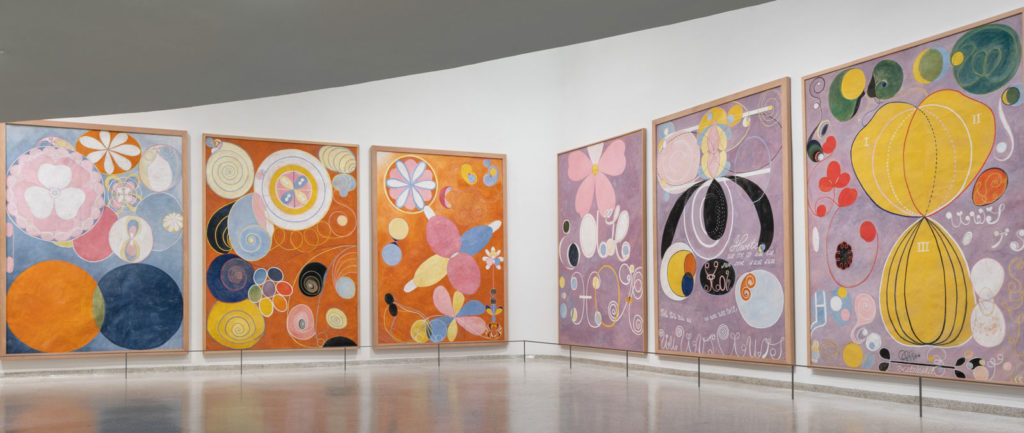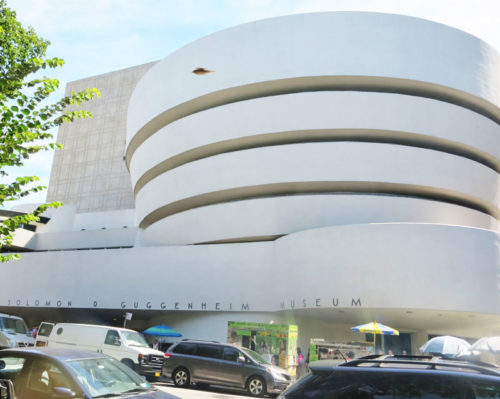The Solomon R. Guggenheim Museum, in NYC, NY, presented “Hilma af Klint: Paintings for the Future”, curated by Tracey Bashkoff. This was the first major solo exhibition of the artist’s work in the United States, April 23, 2019. As Bashkoff states, “Hilma af Klint’s abstract work predates the work by artists such as Kandinsky, Mondrian, Kupka, Malevich, artists that we have long considered the pioneers of abstraction. She begins working in an abstract mode as early as 1906.” Artist and guest writer Tracy Ellyn has written this article in concurrence with the exhibition. She is an internationally acclaimed artist who lives in Miami, Florida.
Hilma af Klint – The Radical, Visionary Female Pioneer
By Tracy Ellyn

Hilma af Klint, The Ten Largest, No. 7., Adulthood, Group IV, 1907. Tempera on paper mounted on canvas, 315 x 235 cm. Stiftelsen Hilma af Klints Verk. Photo: Albin Dahlström/Moderna Museet.
We know all their names. Klee, Kandinsky, Miro, Mondrian, and more. Art history has written them in stone as the 20th century revolutionaries that removed all recognizable objects from their art to the point that they were completely non-objective. What do they all have in common? They were all men.
But one female artist prolifically created non-objective art long before any of them: Hilma af Klint. In fact, her art was so revolutionary that she asked that it not be shown, out of concern that it would not yet be understood. She even went so far as to place in her will that none of it be publicly exposed until at least twenty years after her death. The world was not ready, she believed, to comprehend her paintings of the future.
Why should she be so concerned? Non-objective art had never yet been created. And certainly not by a woman. At the turn of the 20th century, it was difficult, if not impossible, for a female to be an artist, to study under the masters, or to become a member of the male-only art salons and academies of Europe. Women either had no access at all to fine art training, or were given a severely reduced curriculum. Even wives or lovers of well-known artists were shout out from official competitions or similarly rejected.

Hilma af Klint, Group X, No. 1, Altarpiece (Grupp X, nr 1, Altarbild), 1915 rom Altarpieces (Altarbilder)
Oil and metal leaf on canvas, 237.5 x 179.5 cm. The Hilma af Klint Foundation, Stockholm. Photo: Albin Dahlström, the Moderna Museet, Stockholm
And so, Hilma’s revolutionary abstract artworks managed to remain hidden from the world from 1906 until 1986, when they were first exposed. Their biomorphic and geometric forms, steering away from visible reality and toward her own spiritual beliefs that there was a higher dimension beyond what the eye could see, remained in boxes until the late 1960s. The world was not ready for her fine art journey, even as donations.
What happened to Hilma’s oeuvre during the 20th century while art history was writing up all the men we generally think of as the first non-objective artists? After being rejected by Rudolf Steiner, whom she believed was the only man who might understand the spiritual, philosophical and mysterious layers behind her work, Hilma never again dared to show her abstract works, and left them to her nephew. The boxes were never opened until the late 1960’s, long after art history had written of all the male revolutionaries of abstract, non-objective art, but no females.

It was not until 1884 that art historian Ake Fant was able to present Hilma’s work in Helsinki, long after what we would consider the women’s rights movement of the 1960s and 1970s. Hilma’s pieces, which turned inward, away from the material and toward her own automatic forms and spiritual engagement, were finally recognized, long after the 20 years that her will requested.
After more than a 100 year wait, Hilma’s expansive current Guggenheim Museum exhibition in New York City has finally properly placed her in art history, titling the exhibition: “Hilma af Klint: Paintings for the Future”, while The New York Times simultaneously wrote her up as “Hilma Who? No More”. She is finally viewed as the radical, visionary female pioneer that she was. Art history books: Get ready for a massive edit and reprint. The exhibition runs through April 23, 2019.

About the Solomon R. Guggenheim Museum
“Committed to innovation, the Solomon R. Guggenheim Foundation collects, preserves, and interprets modern and contemporary art, and explores ideas across cultures through dynamic curatorial and educational initiatives and collaborations. With its constellation of architecturally and culturally distinct museums, exhibitions, publications, and digital platforms, the foundation engages both local and global audiences.” The Museum is located at 1071 Fifth Ave., New York, NY. For hours visit this page. For more information about this exhibition visit the Solomon R. Guggenheim website
Fascinating article I find it amazing that this body of work was so completely ahead of its time
Beautiful art works in your galleries and beautiful and subliminally painting your Mark fine artist here in Somerset the UK
Thank you for finding her. Thank you for introducing her to us, who may yet learn to see.
Thank you, Mary Lou. I’m glad you enjoyed it. I find it fascinating that she was the revolutionary of non-objective art, before the men, but the men got all the credit. In any case, it is a stunning exhibition.
Tracy, I loved reading your important article. Hilma’s work is powerful and almost beyond comprehensible description. It is the beyond!
Thank you for writing about her art.